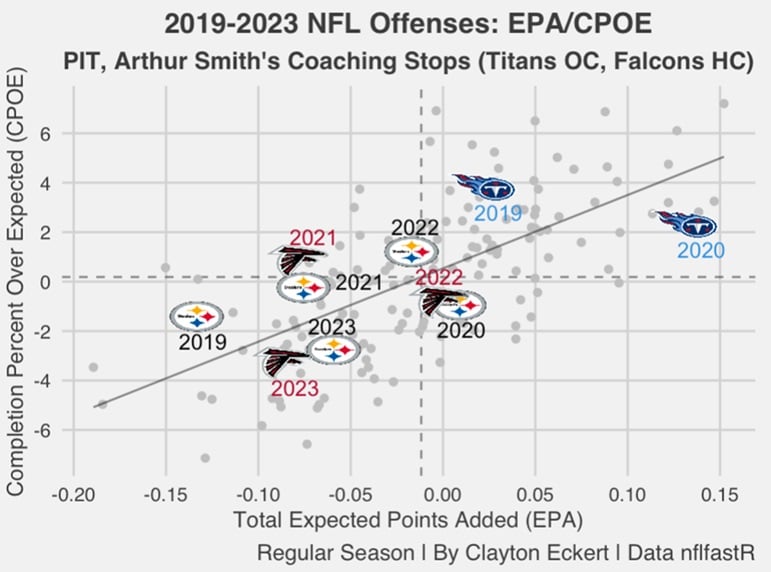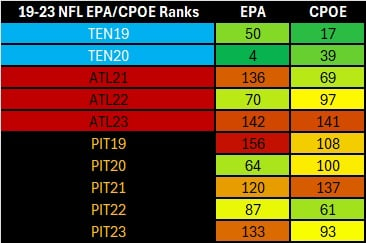Today, I wanted to continue a series learning about new Pittsburgh Steelers offensive coordinator Arthur Smith’s previous coaching stops. Smith was the OC in Tennessee for two seasons (2019-2020), the title he’s returning to with Pittsburgh after a three-year head coaching stint in Atlanta (2021-2023).
This article will look at NFL offenses EPA (expected points added on run and pass plays), along with completion percent over expected (CPOE) since 2019, with the goal of seeing how Pittsburgh and Smith’s squads stacked up in the timeframe.
Here are the results:
Like many of my studies on Smith, his time as OC in Tennessee yielded the best results of focused teams, above the mean in both data points each season. His second year there (2020) boasted a fantastic EPA that ranked fourth-best out of the 160 qualifying teams in the span.
Having the NFL’s leading rusher in Derrick Henry was a huge part along with wide receiver A.J. Brown, and quarterback Ryan Tannehill having two of his best seasons under Smith. 2020 was a respectable CPOE season ranking 39th, and fared even better at 17th the previous year, which was the best of teams in our sights.
Their EPA came in at 50th in 2019, still second-best of highlighted teams. Smith’s time in Tennessee clearly wins out across the board and hopefully translates to Pittsburgh. Otherwise, we see that his time in Atlanta was stale in comparison along with all five Steelers teams landing below the mean in one aspect or another.
Here’s how Smith’s Falcons days stacked up:
ATL21: EPA (136th), CPOE (69th).
ATL22: EPA (70th), CPOE (97th).
ATL23: EPA (142nd), CPOE (141st).
Smith’s first season touted his strongest rank as a head coach, an above the mean CPOE with quarterback Matt Ryan. In totality though, their EPA number tells a different story, landing well below-average.
That was even more true last season, unfortunately, ranking bottom 20 out of the 160 qualifiers in both stats. The prior 2022 season was their best year but lackluster compared to Smith’s results with the Titans overall.
A return to that OC job title, along with a more talented roster on paper in Pittsburgh, will hopefully lend to a positive trend in the Steel City.
Now, let’s compare that to Pittsburgh:
PIT19: EPA (156th), CPOE (108th).
PIT20: EPA (64th), CPOE (100th).
PIT21: EPA (120th), CPOE (137th).
PIT22: EPA (87th), CPOE (61st).
PIT23: EPA (133rd), CPOE (93rd).
Largely uninspiring results. In the five-year span, only two above the mean results: EPA in 2020, and CPOE in 2022. The former with the now-retired QB Ben Roethlisberger, along with RB James Conner as the leading rusher, and three 800-plus yard receivers (Diontae Johnson, Chase Claypool, and JuJu Smith-Schuster). Boy how time flies, none of these players donning the Black and Gold anymore.
2022 fared better than I anticipated, with former Pittsburgh QBs Mitch Trubisky and rookie Kenny Pickett posting the Steelers best CPOE in the timeframe, also landing above all three Falcons squads as well. This speaks volumes to concerns the results overall considering the Steelers 2022 offense wasn’t exactly lighting up the league.
Pittsburgh has since overhauled the QB room. In a similar Russell Wilson, Justin Fields EPA/CPOE Study, Wilson ranked third-best in the NFL last year in CPOE, compared to Pickett being seventh-worst, while Fields was closer to average. If Wilson hangs onto the starting QB role, the expectation as we sit here today, here’s to hoping similar results marry with Smith rekindling his marks in Tennessee.
The flipside to the quarterback study was EPA, where each were below-average. Their order in the rankings remained the same though, with Wilson just below average (18th), then Fields (24th), and Pickett fifth-worst. The new Steelers QBs are in a better situation on paper for 2024, so hopefully we see that trend positively in their opportunities this season.
Substantial investments were finally made in hopes of getting the offense right in Pittsburgh, including Smith, and knock on wood that’s exactly how it unfolds.
To close, here’s a wrap-up rankings table of the data:



